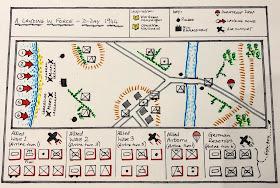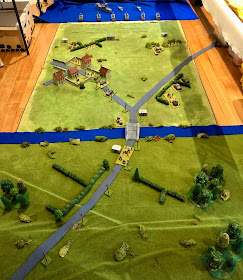This WW2 wargame game begins as dawn breaks on the North French coast. Troops are landing and airborne units being dropped behind enemy lines to capture a vital bridge. Will the Allied forces be able to create a beachhead or will they get stuck on the beach in this game?
 |
| Newspaper Headlines |
A quick recap on the Allied plan.
- Secure the beach and destroying the gun emplacement is a priority
- Airborne troops to capture and hold bridge
- Skirt the town by moving up the left flank as quickly as possible to control the bridge
- Contain threat from town forces until the bridge is fully secured
 |
| Map, Units, and Allied Plans |
First Wave ashore and Airborne landings (06:00 to 08:00)
Wave 1 started well for the Allies with 6 of the possible 8 units making it to shore successfully. The remaining 2 units had to circle around and attempt to come ashore again. The Allied units soon made some headway and began to widen the gaps in the minefields.
German defensives soon responded destroying a landing craft (reducing the chances of later waves arriving on time). They also moved forward an armoured car unit and armoured AT guns to support breach defenders. The armoured cars were destroyed on route by Allied air support.
Further inland, Airborne units successfully arrived at the drop zone without loss. They quickly organised themselves and set about moving towards their objective, seizing the bridge.
 |
| First wave of Allied units arrive. |
 |
| Airborne troops arrive at their drop zone. |
 |
| German armoured units move forward, but come under fire from Allied Air Support. |
 |
| Slow progress clearing mines and landing craft are sunk by gun emplacement. |
Second Wave arrives ashore (08:00 to 10:00)
The beach was getting congested with wave two arriving and progress off the beach was slowing. Importantly the gun emplacement was put out of action, any further loss of landing craft from its guns would have caused critical delays in troops arriving. German artillery was starting to be a problem for Allied units as they tried to organise themselves to breakout from the beach.
Airborne units quickly regroup and moved to assault the bridge. The one nearby German unit had started to move towards the beach and was ordered to backtrack to the bridge after airborne units were spotted.
 |
| Wave 2 units arrive as units try and get off the beach. |
 |
| Airborne units attack the bridge. |
Third Wave arrives (10:00 to 11:00)
Due to the beach congestion Allied forces struggled to get many wave 3 units to the beach. German forces were successfully containing them on the beach. Inland the news was better, airborne troops were close to their objective of securing the bridge.
 |
| Allied troops struggle to breakout of the beach area. |
 |
| Airborne units close in on their bridge objective. |
Reserves arrive (11:00 to 12:00)
German reserves started to arrive and moved quickly down the road to engage Allied airborne units. Fortunately, Allied air support arrived and took some of the sting out of Germans before they began the counterattack.
Finally, on the left flank Allied units are able to move off the beach and begin their attack on the hill. An important breakthrough if they want to reach the bridge in time. On the right flank units were still stuck on beach and supporting units still afloat and struggling to land.
 |
| German reserves arrive. |
 |
| On the beach Allied units are finally able to get off the beach to hopefully being their advance. |
Breakout and counterattack (12:00 to 15:00)
From the congested beach Allied units were able to breakout and successfully attack the hill on their left flank. However, any advance gained was now being hampered by the arrival of German air support.
Airborne units captured the bridge, but were under extreme pressure from the counterattacking German tanks and armoured infantry.
 |
| The bridge is finally captured as airborne units prepare to hold it from counterattacking Germans. |
 |
| As Allied units attempt to breakout from the beach their advance is hampered by German air support. |
Breakout and seize the bridge (15:00 to 19:00)
Allied units are delayed advancing down the left flank by a lone artillery unit with support from mortars in the village. The last of the airborne troops was hanging on grimly at the bridge. The lone artillery unit was finally eliminated and all available forces raced towards the bridge. The last airborne unit had just managed to hang on with the help of air support.
The Germans broke off the counterattack when Allied tank units arrived at the bridge.
 |
| Allied artillery and mortars move forward to support the breakout |
 |
| Allied units rush towards the bridge. A lone artillery units with supporting mortar fire from the village threaten to delay the advance. |
 |
| Allied air support frustrate the German counterattack as they attempt to recapture the bridge |
 |
| Newspaper headlines |
Notes on the game...
- Using landing craft models to indicate areas on the beach where Allied units arrive worked out well. Units cannot arrive if a landing craft is destroyed or the beach in front of a landing craft is not clear.
- Destroying the gun emplacement early is key. If it destroyed landing craft getting units on to the beach becomes very problematic.
- Air support was particularly effective for the Allies, particularly in supporting the paratroopers, without it they may not have held the bridge.
- I used card activation in my last WW2 campaign and continued using it in this game. It provides a level of uncertainty I enjoy as a solo wargamer. The option for an unactivated unit to evade when shot at was used a number of times in the game and worked out well. (See previous post on rules).
 |
| Playing cards allocated to units for activation. |
It was most enjoyable to spend a full day wargaming. Playing the game on the floor worked out fine and I had so much fun, particularly as I avoided standing on any of the models. I did need to take breaks as squatting down to move units became tiring as the day progressed. I am not nearly as flexible or youthful as the last time I played a game on the floor in the early 1970's.



















































